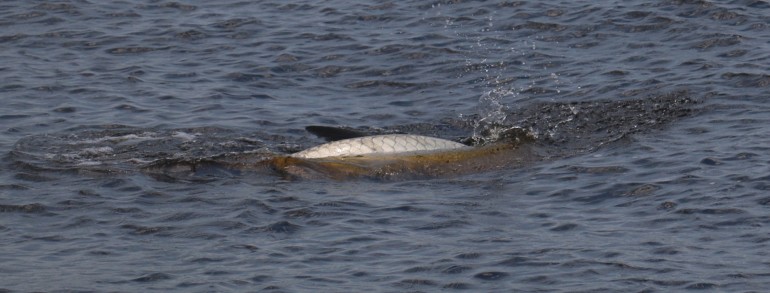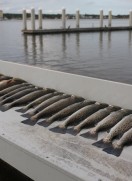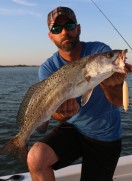We're transitioning into May, and with it, some new fish species! I don't know about everyone else, but by mid to late Spring, I'm about ready to fish for something other than Sheepshead and Trout. It was a fun Sheepshead season, but I'm ready for something else.
So, whats on the menu? Cobia and Tarpon. the Cobia run is upon us. Water temps in Mayport Inlet are sitting right around 69 to 70 degrees. Cobia tolerance ranges are right at about 70 degrees. They can handle a bit less than 70 but will stay closer to that mark. That being said, they should be here. If not, very close by. By close, I mean Vilano or even further North. Another species that will start rolling in any day now is the Atlantic Tarpon. They have a similar temperature range of 71 to 73 degrees on their lower end. Ill talk more about them in the following weeks as they get closer.
There are a number of ways to target Cobia. You can catch them near shore, in the Menhaden pods, you can find them in the Mayport Inlet rips, you can also find them swimming with the Manta Rays running the beach. If all else fails, you can't go wrong deep jigging for them on the nearshore wrecks. All these options produce, in the end, it all boils down to preference.
Sight fishing for them on rays is a blast, however, when boats are everywhere competing with each other to find that diamond in the rough Manta Ray, it can get frustrating. Especially when Cobia are scarce. Often times, you'll find a dozen or more Manta Rays with nothing on them. Dry Rays(what we call a ray with no fish with it)will always out number the ones harboring fish. It's that very reason that many anglers prefer fishing the Menhaden pods.
Fishing the pods puts far less wear and tear on your motor/'s, you'll use less gas, and tends to be more productive. You never know what you'll find in a Menhaden pod. The usual suspects are Spanish Mackerel, giant Jacks, Bull Reds, King Fish, Bonita's, Sharks, Tarpon, and of course, Cobia. Fishing a Pogy pod is relatively easy. Keep your boat a good casting distance away. If your boat doesn't have a trolling motor, you'll have to stage the boat up current and cast towards the pod. since the bait schools will be moving faster than the current, you'll want to stage well ahead, possibly even further than a cast distance. Fire a bait or two into the path of the incoming school and hang on! Rinse and repeat a few times until you get bit. If the pod yields no action or seems devoid of predators, move on and find another pod.
The use of a trolling motor is invaluable when pod fishing. You can keep up with the bait school without making too much noise. This is especially important on days when boaters are thick in the area. Heavy boat presence will make fish skittish and often times send the target species deeper where you cant see them. Being able to remain stealthy while closing the gap between the boat and a school of bait makes all the difference in the world. Especially when you're trying to read whether or not a bait pod is being fed on.
A bait pod that's alive with predators will show signs. Pods with no predator presence will usually take the form of an oval or circle. The menhaden will be somewhat spread out. Then on the other hand, a bait pod being fed on will look malformed with open holes in it, or gaps. Essentially, the pod will look broken up. The fish will also be clumped tightly together right at the surface. You'll usually see predator fish ripping through the school.
Often times, you'll see predator fish casually swimming in the center of the pod not actually feeding. This is especially common with Barracudas, Sharks, Tarpon, and Cobia. Simply tossing a flat lined Pogy in front of these guys will usually trigger a reaction bite. Predator fish key in on injured fish. A flat lined Pogy with a hook in it's tail or nose will look injured and most of the time, will result in a strike. Even though there are thousands of the same exact type of bait in close proximity, the one on your hook looking hurt will be targeted.
Fish the entire column! Don't be afraid to fish multiple lines in a pod covering multiple depths. Often times a pod can and will stretch a long distance from the surface to the bottom. Its not uncommon for the target species to run deeper, feeding on the lower half of the pod. Having weighted baits out will land you all the usual species with the added benefit of huge Red Fish that tend to stay down by the bottom. When the bites tough, an elusive Bull Red or two can be a day saver.
Jacksonville Fishing charters. Jacksonville charter fishing. Guide fishing Jacksonville. Fishing guides Jacksonville. Charter fishing Jacksonville. Jacksonville Sport Fishing. Sport Fishing Jacksonville. Mayport charter fishing. Mayport Sport Fishing.





admin
Danny Pardue